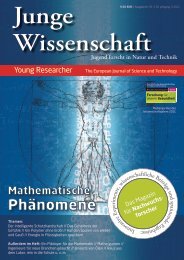2008: Das Jahr der Mathematik - Junge Wissenschaft
2008: Das Jahr der Mathematik - Junge Wissenschaft
2008: Das Jahr der Mathematik - Junge Wissenschaft
You also want an ePaper? Increase the reach of your titles
YUMPU automatically turns print PDFs into web optimized ePapers that Google loves.
Jugend forscht<br />
Jugend forscht<br />
Short-term Adaption of Primary<br />
and High-or<strong>der</strong> Visual Areas<br />
A Psychophysical Experiment<br />
Visual adaptation is a known phenomena induced when the visual system is exposed to the same stimulus for a<br />
prolonged time. When the stimulus is turned off one of the systems’ calibration mechanisms are caught off-guard and<br />
visual perception is briefly perturbed. In our study, we conducted for the first time a psychophysical experiment on<br />
short-term adaptation of primary and high-or<strong>der</strong> visual areas.<br />
1 Introduction<br />
Vision is the most dominant sensory modality<br />
of primates. When light enters the eye,<br />
photoreceptors in the retina transform the<br />
energy into electrical signals. These signals<br />
are then sent by interneurons to ganglion<br />
cells. The fibers of the ganglion cells cross at<br />
the optic chiasm and terminate in the lateral<br />
geniculate nucleus (LGN). Visual information<br />
is then transferred to the primary<br />
visual cortex (V1). V1 is one of the most<br />
studied cortical areas, it is also called<br />
the striate cortex or area 17, located in the<br />
occipital lobe at the back of the brain, two<br />
millimeters thick and densely packed with 6<br />
layers of cells.<br />
From V1, information is sent to other areas<br />
of the visual cortex for further, higher analysis.<br />
Visual information is then divided into<br />
two paths known as the ventral and dorsal<br />
stream. The ventral “what” stream controls<br />
recognition, object representation and memory<br />
while the dorsal “where” stream runs<br />
motion and object locations.<br />
A variety of experimental procedures has<br />
been developed for demonstrating the<br />
cortical architecture and the unique pattern<br />
of activation for each group of cells.<br />
In their pioneering electrophysiological<br />
studies of monkeys and cats, Hubel and<br />
Wiesel worked out the appropriate light<br />
stimuli for various cortical cells [5]. It was<br />
found that V1 has neurons with elongated<br />
receptive fields which respond best to simple<br />
stimuli such as bars, lines and edges. V1<br />
neurons also have spatial-frequency<br />
seletivity and respond to luminance changes.<br />
Visual cortical neurons are highly tuned and<br />
specialized for processing a certain aspect of<br />
Autoren<br />
Ilana Malekan, *1989<br />
Muttontown, NY, USA<br />
Yoni Smolin,*1988<br />
Nazareth Illit., Israel<br />
Eszter Turi, *1987<br />
Csorna, Ungarn<br />
Teilnehmer am Scitech 2005 des<br />
Technion, Haifa, Israel<br />
Eingang <strong>der</strong> Arbeit: März 2007<br />
Zur Veröffentlichung empfohlen:<br />
April 2007<br />
32<br />
<strong>Junge</strong> <strong>Wissenschaft</strong> 79 // 1/<strong>2008</strong> //<br />
Short-term Adaption of Primary and High-or<strong>der</strong> Visual Areas










